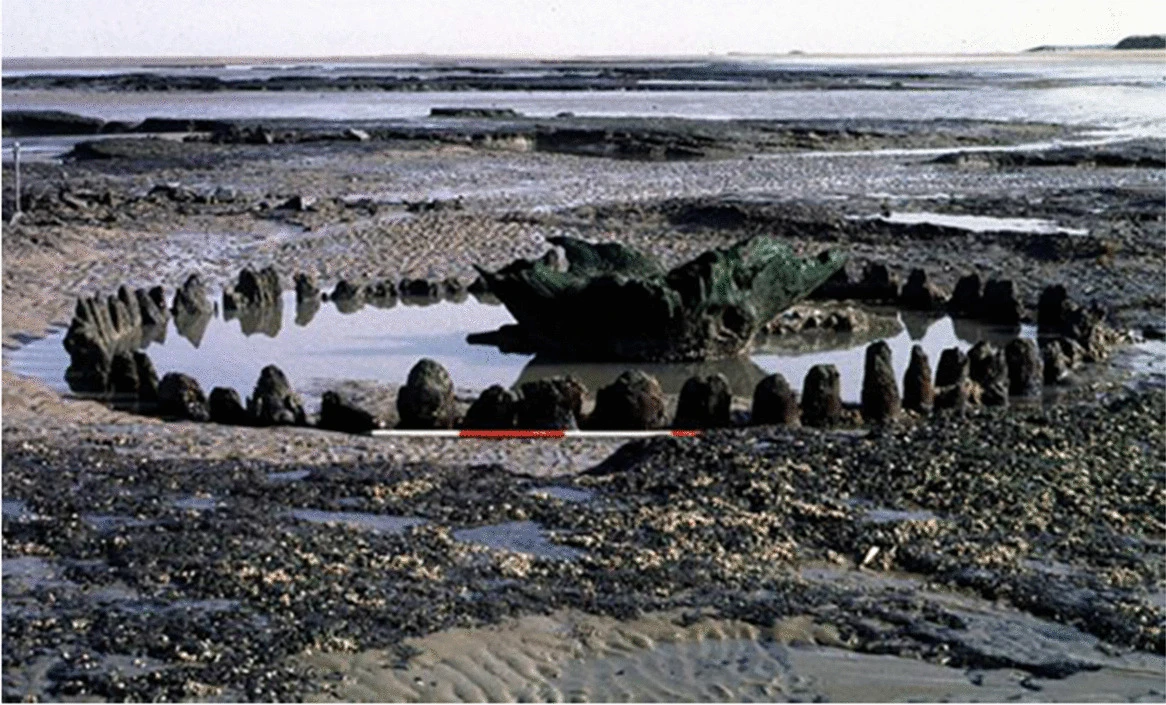
During the summer of 1998, shifting sands on a beach on the east coast of England exposed an ancient monument. Fifty-five oak posts had been situated in a 15-foot-wide circle, and an upturned tree stump was planted in the middle.
Scientists were able to date the monument to 2050 B.C.E. during the Bronze Age. While the monument has been nicknamed Seahenge, scholars referred to it as Holme I, named after the location where it was found.
“It is not a henge, neither is Stonehenge for that matter, although henges sometimes have timber and stone circles in them,” says David Alexander Nance with the Department of Geography and Environment at the University of Aberdeen in Scotland.
Seahenge Is Not a Henge
To be considered a henge, a monument must involve “earthwork,” a term that archeologists use to describe changes that ancient builders made to the landscape, like creating levels, mounds, or ridges.
Seahenge is also not a timber circle. Timber circles are larger, and the timbers are typically placed widely like columns. The 55 oak logs in Holme I are close together, which adds to scholars’ debate as to what its ancient creators intended.
Without written or physical evidence that confirms how the ancients used Seahenge, scientists will never fully know. Some suggest the logs’ close location means they were used as a type of stockade.
Others suspect it was used as a ceremonial site. Nance believes it was related to the cuckoo bird, which was associated with summer.
“Holme I is a cuckoo pen, constructed to resemble the imagined wintering places of the cuckoo before migration was known about,” Nance says.
Early Bronze Age Building
Nance suggests the monument was built on the summer solstice, the time when the cuckoo was thought to have stopped singing and departed for the Otherworld, taking the warm summer weather with it. The monument was meant to resemble the cuckoo’s winter home in the Otherworld, so the confused bird would stay put, continue singing its song, and summer would remain.
Nance’s research has found Holme I was built during a stressful time when temperatures were colder. Trying to maintain warmer weather by tricking the cuckoo into remaining might have been the builders’ attempt to stave off winter.
When Seahenge was built, the area was a salty marsh, not a beach. Over time, peat covered the monument, which likely helped preserve it for thousands of years. The people who built Seahenge put it in a protected area, away from the sea.
“They were Early Bronze Age people of the Bell Beaker culture. Probably pastoralists and the ancestors of the present-day northern Scottish and Irish,” Nance says.
Read More: Finding Monuments Beyond Stonehenge
Saving Seahenge
When Seahenge reemerged in 1998, it was located on a private estate. Many groups began advocating for the ancient monument’s future and whether it should be left in place or removed.
Although Seahenge was originally built in a marsh, coastal erosion meant the landscape around it had changed. By 1998, it was on a sandy beach and submerged underwater during high tide.
Organizations like English Heritage (a group that cares for more than 400 historic sites) advocated that the monument be excavated and preserved in a museum to prevent salt water from destroying it. The private estate agreed, but other groups didn’t.
Ancient Excavation
Local residents were unhappy about the excavation because the decision had been made without a larger discussion that involved their input. People who identified as Druid were also unhappy. To them, Seahenge was not just an important cultural site but also a potential place to worship.
The Holy Roman Empire dominated Europe and the British Isles by the 500s and pushed for conversion to Christianity. Although some pagan rituals or religious sites were repurposed to align with Christian beliefs, many were simply demolished.
To some modern-day Druids or Pagans, Seahenge represented a rare opportunity to worship at a site built by their ancestors.
Read More: Five Megastructures From The European Stone Age Still Around Today
Where Is Seahenge Now?
A British court agreed that because Seahenge was on private property, the owners were free to allow the excavation. The oak stumps and tree-stump centerpieces were removed and then placed in cleansing tanks to remove mud and salt.
The pieces were analyzed by researchers and eventually put on display at a museum about 20 miles from where the monument once stood.
Read More: Drought Uncovers Ancient Irish Henge
Article Sources
Our writers at Discovermagazine.com use peer-reviewed studies and high-quality sources for our articles, and our editors review for scientific accuracy and editorial standards. Review the sources used below for this article:
Emilie Lucchesi has written for some of the country’s largest newspapers, including The New York Times, Chicago Tribune and Los Angeles Times. She holds a bachelor’s degree in journalism from the University of Missouri and an MA from DePaul University. She also holds a Ph.D. in communication from the University of Illinois-Chicago with an emphasis on media framing, message construction and stigma communication. Emilie has authored three nonfiction books. Her third, “A Light in the Dark: Surviving More Than Ted Bundy,” releases October 3, 2023 from Chicago Review Press and is co-authored with survivor Kathy Kleiner Rubin.




